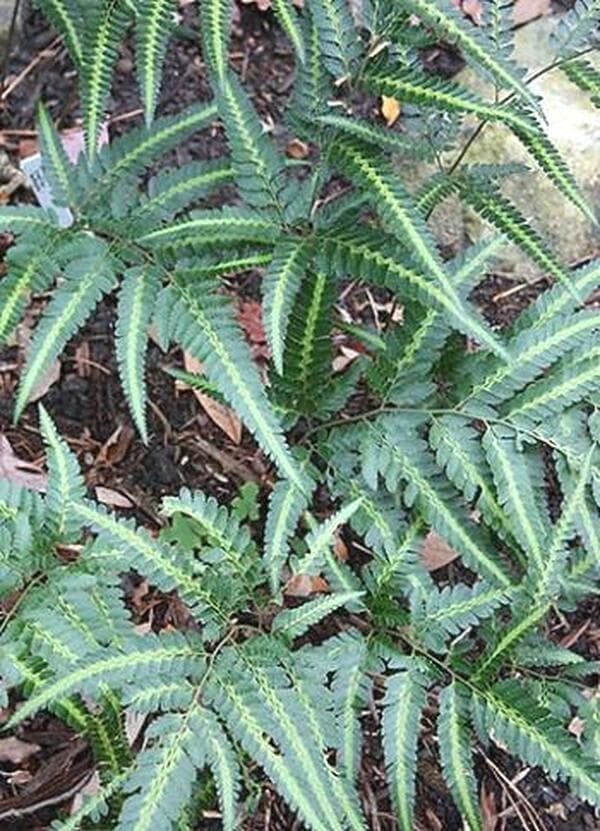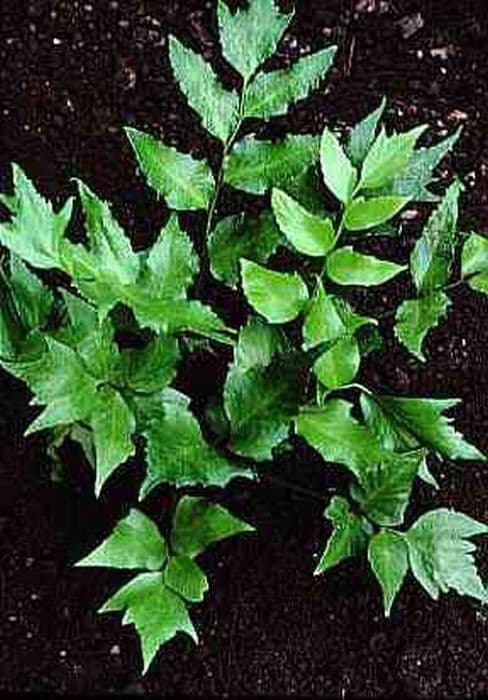Black Wood Fern Dryopteris atrata (Wall. ex Kunze) Ching

ABOUT
The plant commonly known as the Shaggy Wood Fern is an attractive species that exhibits a lush, green presentation. It has a structured, yet somewhat sprawling form that contributes to its elegant visual effect. The leaves, known as fronds, are the most defining feature of the Shaggy Wood Fern. These fronds are divided into numerous leaflets that give them a feathery appearance. The leaflets are arranged on each side of a central stem, which is known as the rachis. They have an intricate, lace-like look due to the way they are cut, and their edges could range from being finely to coarsely toothed. This makes the edges appear somewhat serrated, adding to the visual complexity of the foliage. The leaflets taper towards the tip of the frond and are attached to the rachis in a staggered or alternating pattern. In terms of color, the Shaggy Wood Fern is a deep green that may appear almost glossy in the right light. This color adds a depth of beauty to shady garden areas or woodland settings where it is commonly found. Depending on the time of year and environmental conditions, the fronds might display a range of green shades, from a brighter, more vibrant green to a deeper, more muted hue. The overall appearance of the Shaggy Wood Fern is one of lushness and dense foliage, with the fronds emerging from a central point, often resembling a fountain of greenery. This dense arrangement can make the center of the plant appear very full and can create an impression of a compact cluster from which the fronds elegantly spread outwards.
About this plant
 Names
NamesFamily
Dryopteridaceae.
Synonyms
Black Wood Fern, Shiny Wood Fern.
Common names
Aspidium atratum Wall. ex Kunze, Nephrodium atratum (Wall. ex Kunze) Hook., Lastrea atrata (Wall. ex Kunze) Bedd., Dryopteris hondoensis Koidz., Dryopteris ogasawarensis Koidz.
 Toxicity
ToxicityTo humans
Dryopteris atrata, commonly known as the Shaggy Wood Fern or Shaggy Shield Fern, is not typically recognized as a poisonous plant to humans. There is no significant data reporting its toxicity or symptoms related to poisoning by ingesting parts of this fern. As with any plant, individual sensitivities may exist, and it is generally not advisable to consume any plant matter that is not explicitly known to be safe for human consumption.
To pets
The Shaggy Wood Fern or Shaggy Shield Fern, also scientifically recognized as Dryopteris atrata, is not known to be toxic to pets. It does not appear on lists of plants commonly recognized as poisonous to domestic animals. However, as with any non-food plant, ingestion of plant parts by pets may cause gastrointestinal discomfort or an individual allergic reaction. Owners should prevent pets from eating ornamental plants and monitor for any signs of distress if ingestion occurs.
 Characteristics
CharacteristicsLife cycle
Perennials
Foliage type
Evergreen
Color of leaves
Green
Height
2 feet [60 cm]
Spread
2 feet [60 cm]
Plant type
Fern
Hardiness zones
5
Native area
Asia
Benefits
 General Benefits
General Benefits- Economic value: The plant is used in horticulture and landscape design, contributing to the gardening economy.
- Erosion control: It can help to stabilize soil and prevent erosion due to its root structure.
- Habitat support: Provides habitat and food for various insects and wildlife.
- Aesthetic appeal: Adds beauty to gardens and natural landscapes with its fern-like appearance.
- Shade tolerance: It can thrive in shaded areas where other plants may struggle, offering greenery to dim spots.
- Low maintenance: Once established, it requires minimal care, making it a convenient choice for gardeners.
 Medical Properties
Medical PropertiesThis plant is not used for medical purposes.
 Air-purifying Qualities
Air-purifying QualitiesThis plant is not specifically known for air purifying qualities.
 Other Uses
Other Uses- Dryopteris atrata, commonly known as Shiny Wood Fern, can be used as a natural pest repellent when its fronds are placed in closets or drawers to deter moths and other insects.
- The plant is sometimes incorporated into floral arrangements for its lush, green foliage, which can add texture and a woodland aesthetic to bouquets and centerpieces.
- Shiny Wood Fern is used in terrariums and fairy gardens because of its manageable size and ability to thrive in the humid, enclosed conditions these mini-ecosystems provide.
- Because of its attractive foliage, it is also popular in shade gardens where it can provide a contrast to flowering plants and serve as a lush, green backdrop.
- It can be used as a natural indicator for soil moisture levels in the garden; the fern's health directly correlates to the soil's dampness, providing gardeners with a visual guide for watering.
- The fronds of the Shiny Wood Fern are sometimes harvested and used in crafts, such as wreath making, for their structural qualities and natural beauty.
- In landscape design, it's used for erosion control on slopes and banks, as its root system helps to stabilize the soil.
- Given its texture and uniform appearance, it can be used as a living mulch, suppressing weeds and helping retain soil moisture.
- Shiny Wood Ferns can be planted in containers on patios or balconies where other plants might struggle, due to their shade tolerance and low maintenance needs.
- Residents of woodland areas can use Shiny Wood Ferns to complement native plant garden designs, thus encouraging local wildlife and supporting biodiversity.
Interesting Facts
 Feng Shui
Feng ShuiThe Wood fern is not used in Feng Shui practice.
 Zodiac Sign Compitability
Zodiac Sign CompitabilityThe Wood fern is not used in astrology practice.
 Plant Symbolism
Plant Symbolism- Resilience: The ebony spleenwort, capable of growing in dense forests and on rocky slopes, often symbolizes resilience and the ability to thrive in challenging environments.
- Endurance: This plant can survive in shady conditions where other plants may fail, representing endurance and persistence.
- Protection: Traditionally, ferns have been associated with protection due to their dense fronds, and ebony spleenwort continues this symbolism, offering a sense of safeguarding and shelter.
- Secret Knowledge: In Victorian times, ferns were often considered to hold mystic qualities, and the ebony spleenwort, with its rich green coloration and complex structure, could be seen to embody hidden wisdom or knowledge.
- Health and Recovery: Many ferns have been used medicinally throughout history; ebony spleenwort's hardy nature might symbolize health, wellness, and recovery from illness.
 Water
WaterThe Shaggy Shield Fern requires consistent moisture, so it's important to water it when the top inch of soil feels dry to the touch. This could mean watering approximately once a week, but this frequency can change with the seasons and indoor conditions. When you do water, use room temperature water and apply slowly to the base of the plant until it begins to drain from the bottom of the pot; this might be around half a gallon for a medium-sized plant. Avoid letting the plant sit in water, as this can lead to root rot.
 Light
LightThe Shaggy Shield Fern thrives in dappled sunlight or partial shade and should be protected from direct, harsh sunlight, which can scorch its fronds. The ideal spot for this fern would be near a window with sheer curtains or in a room that receives indirect but bright light throughout the day.
 Temperature
TemperatureThe Shaggy Shield Fern prefers temperatures ranging from 60 to 75 degrees Fahrenheit. It can survive minimum temperatures down to about 50 degrees Fahrenheit, but it should not be exposed to temperatures below this for prolonged periods. Ideal growing conditions are within this temperature range without sudden fluctuations.
 Pruning
PruningPruning the Shaggy Shield Fern is primarily done to remove any dead or yellowing fronds to maintain its neat appearance and encourage healthy new growth. This should be done as needed when you notice unsightly fronds. The best time to prune is in the spring before new growth begins.
 Cleaning
CleaningAs needed
 Soil
SoilShaggy Shield Fern thrives in a well-draining soil mix composed of one part garden soil, one part peat, and one part perlite or sand, which ensures good aeration and moisture retention. The ideal soil pH should be slightly acidic to neutral, ranging from 5.5 to 7.
 Repotting
RepottingShaggy Shield Ferns should be repotted every 2-3 years to refresh the soil and provide space for growing roots. It's best to repot in the spring just before the growing season begins.
 Humidity & Misting
Humidity & MistingShaggy Shield Fern prefers high humidity levels, ideally between 60% to 80%, which can be achieved by placing a humidifier nearby or by grouping plants to create a more humid microclimate.
 Suitable locations
Suitable locationsIndoor
Place in part shade with moist soil.
Outdoor
Plant in shade, keep soil moist, mulch.
Hardiness zone
5-8 USDA
 Life cycle
Life cycleDryopteris atrata, commonly known as the Shaggy Wood Fern, initiates its life cycle as spores, which are typically released from mature ferns and distributed by wind. When the spores land in a suitable, moist environment, they germinate and grow into small, heart-shaped gametophytes (prothalli), which are the sexual stage of the plant. The gametophytes produce both male and female reproductive cells; when water is present, the sperm can swim to and fertilize the eggs, leading to the formation of a zygote. This zygote then develops into a new sporophyte, which is the fern plant people commonly recognize, with fronds unfurling from a rhizome. As the fern matures, it will produce sori on the undersides of its fronds; these are clusters of sporangia that will release spores, completing the life cycle. This slow-growing fern can live for several years, continually reproducing through this cycle.
 Propogation
PropogationPropogation time
Spring to Summer
Propogation: Dryopteris atrata, commonly known as the Shaggy Wood Fern, is typically propagated through spores, a method that is favored for its simplicity and effectiveness. This process begins when the spores ripen on the undersides of mature fronds, usually in late summer. Collectors should pick these fronds just before the spores are set to release and place them in a paper bag, allowing them to dry and release spores. The spores are then sown on the surface of a moist, sterile growing mix, such as peat or a peat-perlite blend. This should be done in a shaded area or environment, as ferns generally do not tolerate direct sunlight. The container needs to be covered with plastic to maintain humidity, and kept at around 68 to 72 degrees Fahrenheit (20 to 22 degrees Celsius). After several weeks to months, with proper care, the spores will germinate and develop into a protonema which eventually gives rise to new fern plants.









